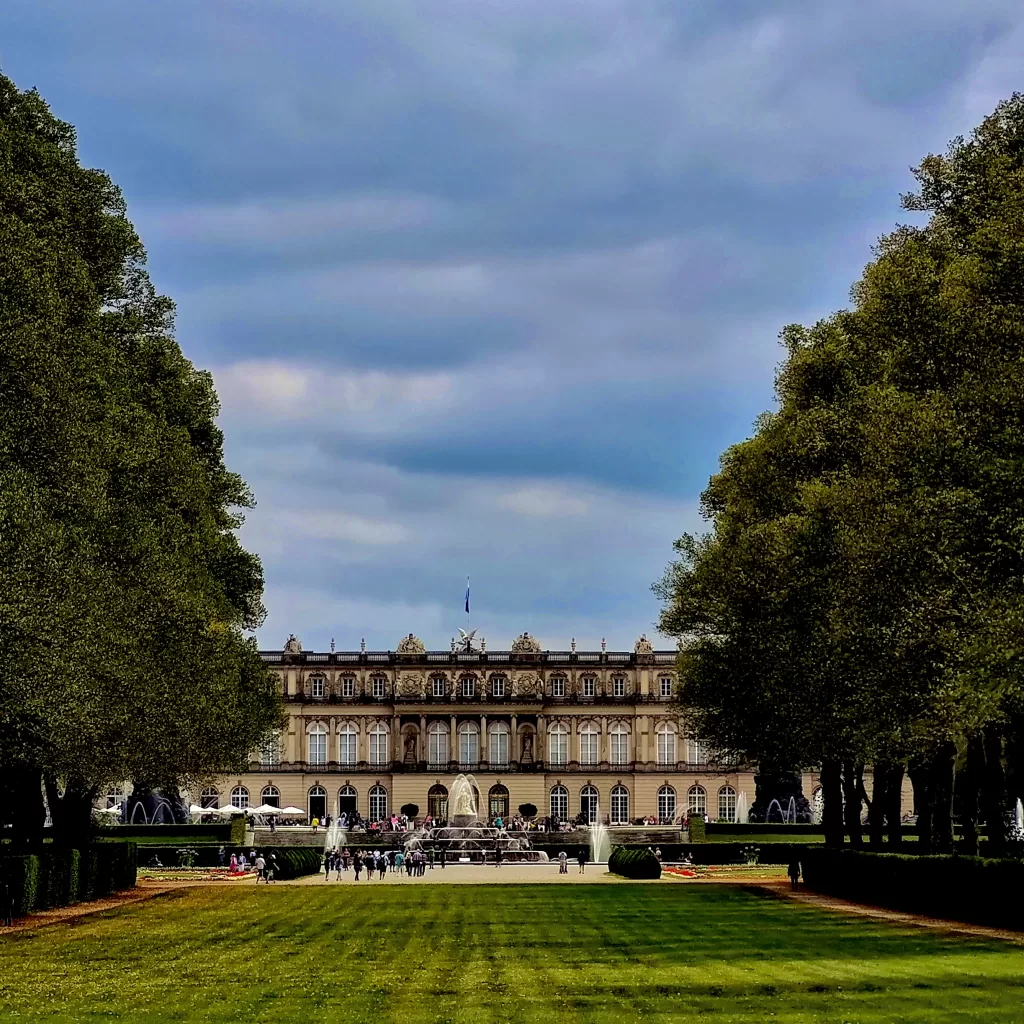 This is our second journey to King Ludwig II of Bavaria’s castles and palaces. Today, we’re exploring Neues Schloss Herrenchiemsee (Herrenchiemsee New Palace). Often called the “Versailles of Bavaria,” this palace was inspired by Louis XIV’s (The Sun King) grand Versailles. King Ludwig II, an admirer of Louis XIV, even referred to himself as the “Moon King.” This palace was the second one Ludwig II planned, following Schloss Neuschwanstein but preceding Schloss Linderhof.
This is our second journey to King Ludwig II of Bavaria’s castles and palaces. Today, we’re exploring Neues Schloss Herrenchiemsee (Herrenchiemsee New Palace). Often called the “Versailles of Bavaria,” this palace was inspired by Louis XIV’s (The Sun King) grand Versailles. King Ludwig II, an admirer of Louis XIV, even referred to himself as the “Moon King.” This palace was the second one Ludwig II planned, following Schloss Neuschwanstein but preceding Schloss Linderhof.
Best time to visit: Late Spring to early Autumn 🌳🍁
I wouldn’t recommend visiting palaces in winter because the gardens lose their lushness, and statues are covered to protect them from freezing temperatures.
How to get there:
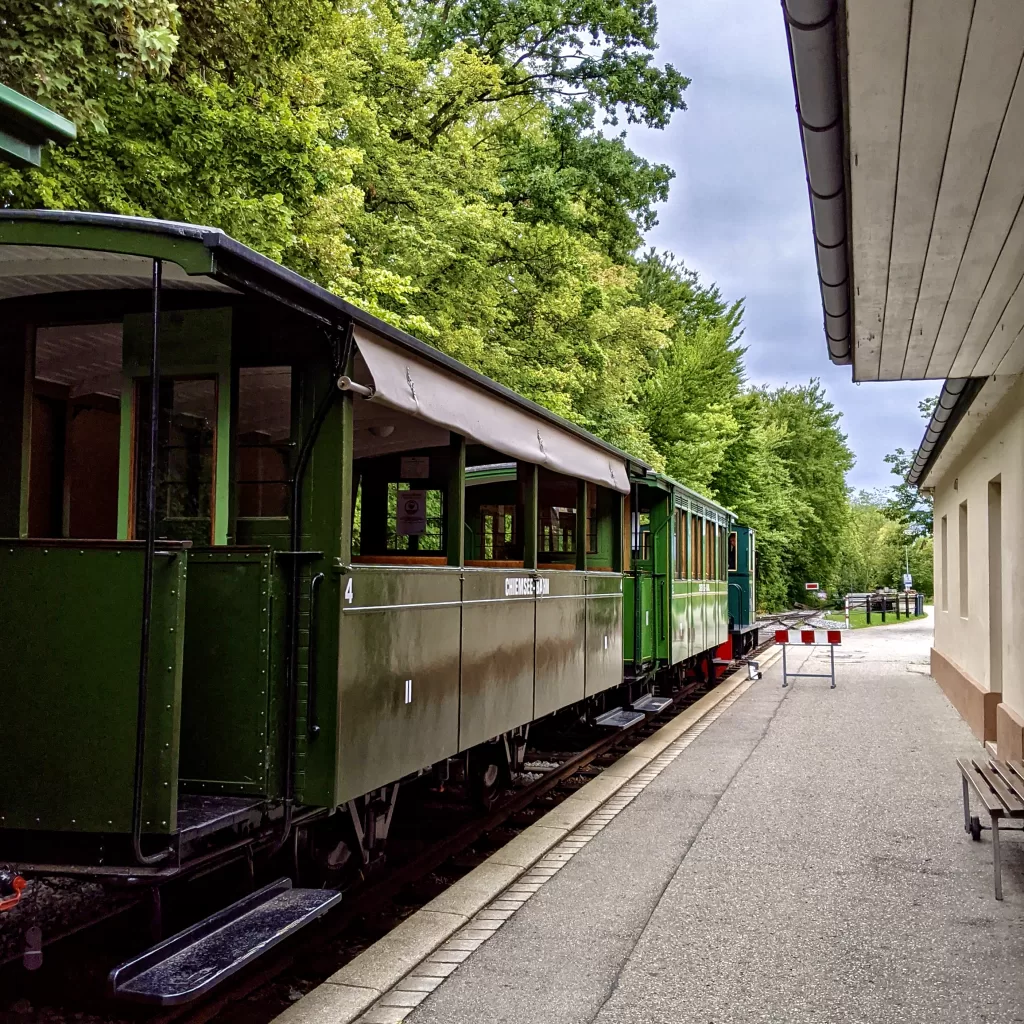 We take a train, either BRB or EC, from München Hbf (Munich Main Station) to Prien am Chiemsee. The journey takes around an hour. Make sure to check Deutsche Bahn’s website for ticket prices.
We take a train, either BRB or EC, from München Hbf (Munich Main Station) to Prien am Chiemsee. The journey takes around an hour. Make sure to check Deutsche Bahn’s website for ticket prices.
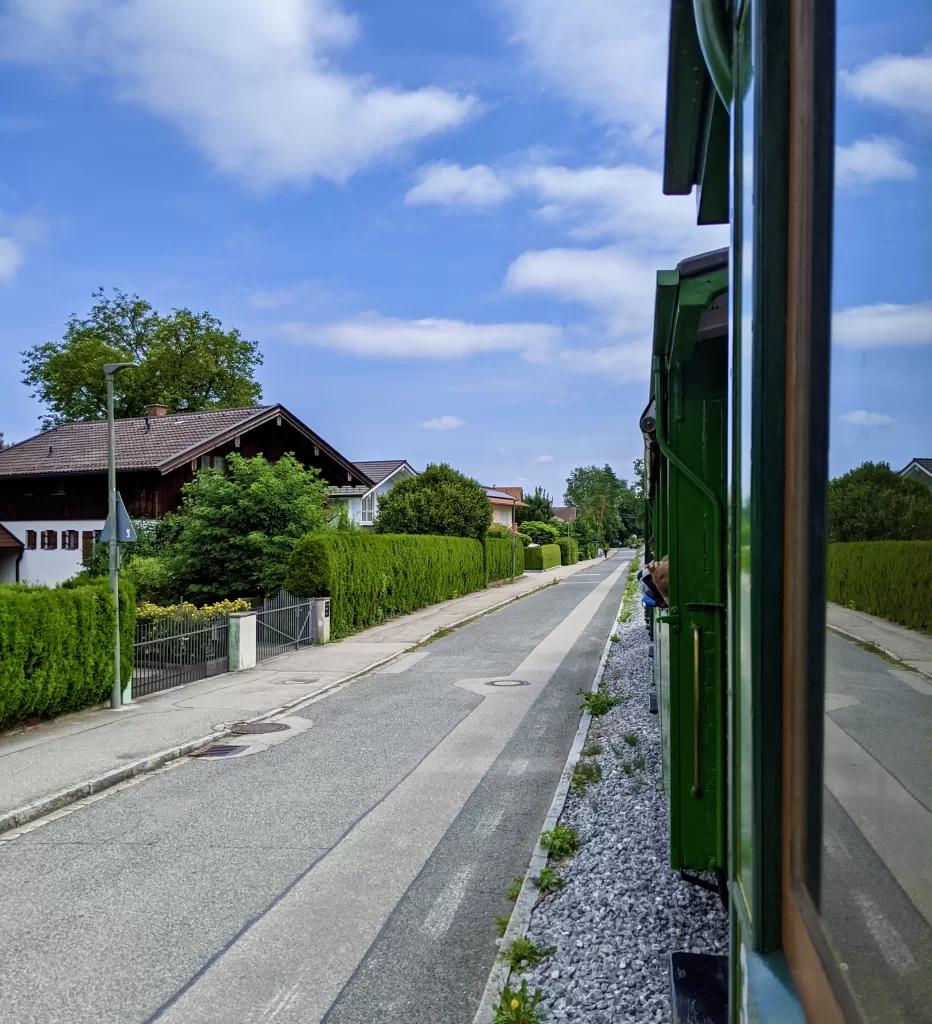 After arriving in Prien, a quaint town in southern Bavaria, we head to the port to catch a ferry to Herreninsel on Chiemsee (Lake Chiem). The port is accessible via a charming old train platform, Chiemseebahn, Bahnhof Prien, located side by side the modern station. Tickets are cash-only, so make sure to withdraw some before your trip.
After arriving in Prien, a quaint town in southern Bavaria, we head to the port to catch a ferry to Herreninsel on Chiemsee (Lake Chiem). The port is accessible via a charming old train platform, Chiemseebahn, Bahnhof Prien, located side by side the modern station. Tickets are cash-only, so make sure to withdraw some before your trip.
Tip: I always opt for round-trip tickets to avoid last-minute ticket-buying stress.
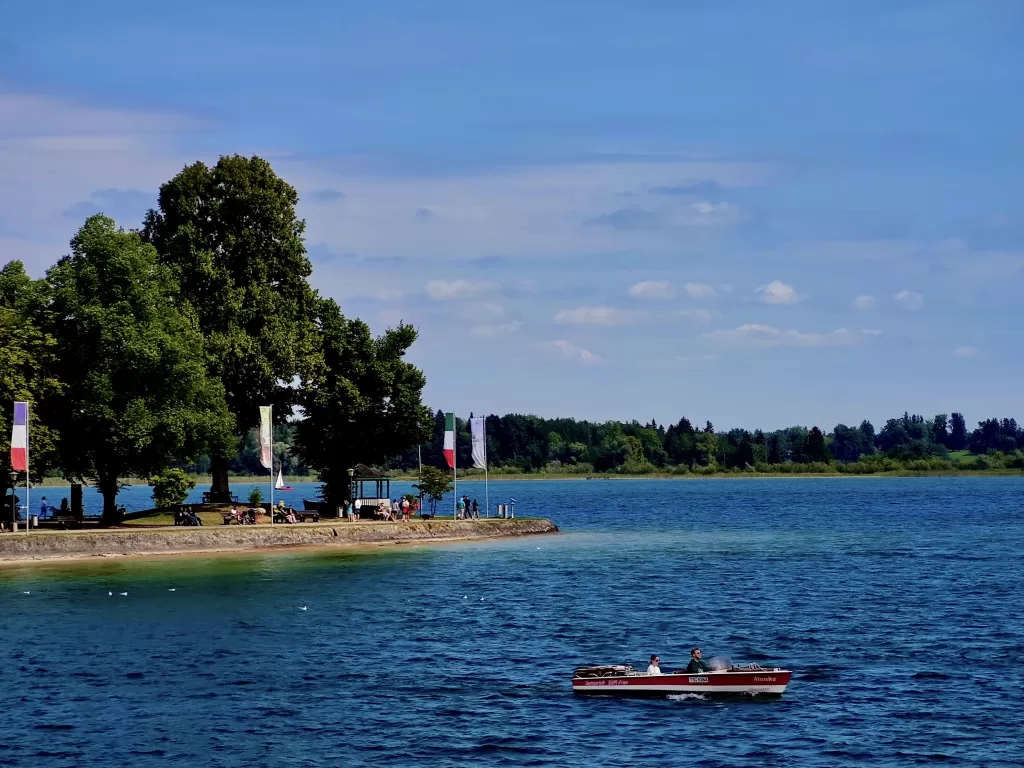
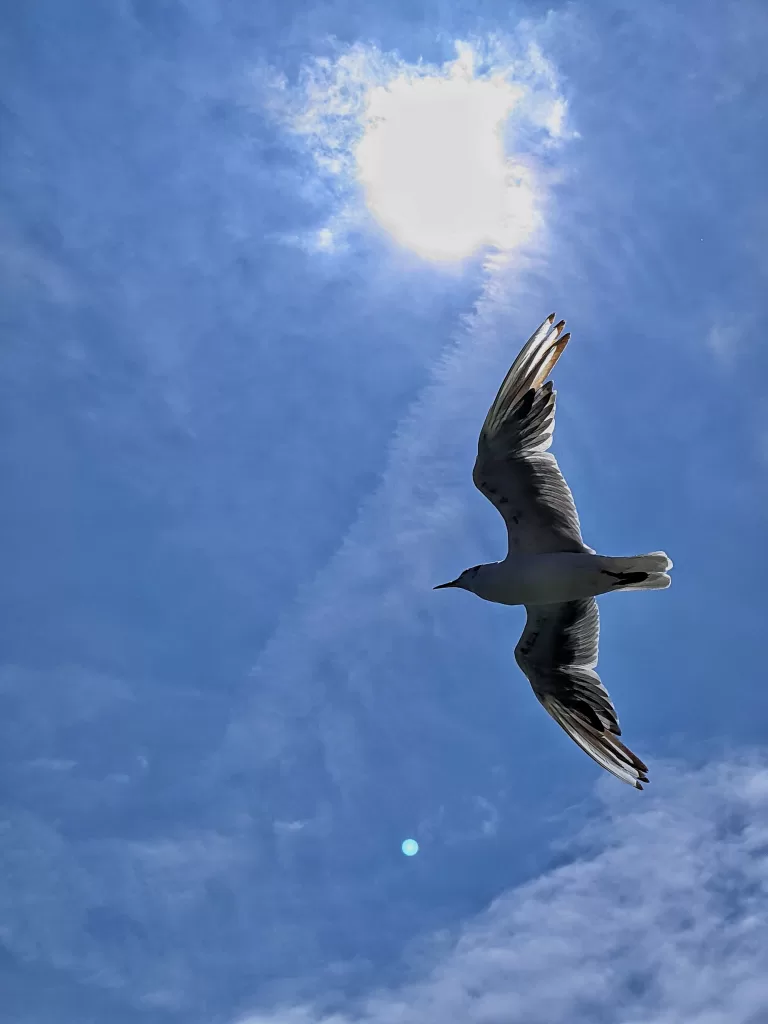
The train to the port, Chiemsee “Prien,” is a vintage model, and you’ll notice that nobody closes the windows. That’s because everyone is busy capturing the scenic views on their cameras and phones. Once we arrive, our next stop is the ticket counter to purchase ferry tickets. You’ll have options: Herreninsel (Men’s Island) and Fraueninsel (Women’s Island) are both accessible from here. For today’s adventure, we’ll opt for a round-trip ticket to Herreninsel. The lakeside is a popular spot for relaxation, so feel free to take a leisurely stroll while waiting for the ferry.
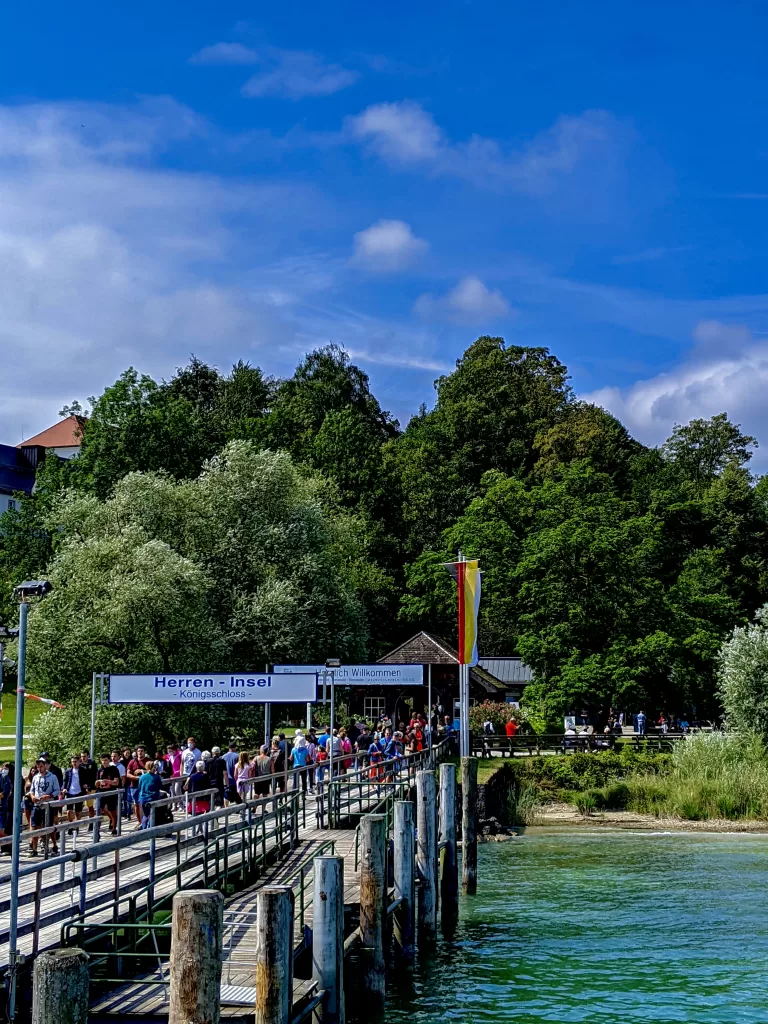 Finally, the ferry arrives, and we’re off to Herreninsel. Even though it’s the height of summer, the lake air retains a slight chill. The ferry’s movement creates an airflow that makes it easier for seagulls to glide alongside us. They’re a common sight, but it’s best to admire them from a distance and respect their space. About 15 minutes later, we reach Herreninsel. Our first task is to head to the ticket counter once more to book a guided tour of the palace. Both English and German tours are available, but remember, they only accept cash.
Finally, the ferry arrives, and we’re off to Herreninsel. Even though it’s the height of summer, the lake air retains a slight chill. The ferry’s movement creates an airflow that makes it easier for seagulls to glide alongside us. They’re a common sight, but it’s best to admire them from a distance and respect their space. About 15 minutes later, we reach Herreninsel. Our first task is to head to the ticket counter once more to book a guided tour of the palace. Both English and German tours are available, but remember, they only accept cash.
With approximately an hour to spare before our tour begins, we have the freedom to explore the island further. You’ll notice that it’s not just a human haven, horses and cows roam freely here as well. However, be cautious – horse-flies are prevalent, and they won’t hesitate to follow and bite you!
Schlosspark Herrenchiemsee: The Palace Garden:
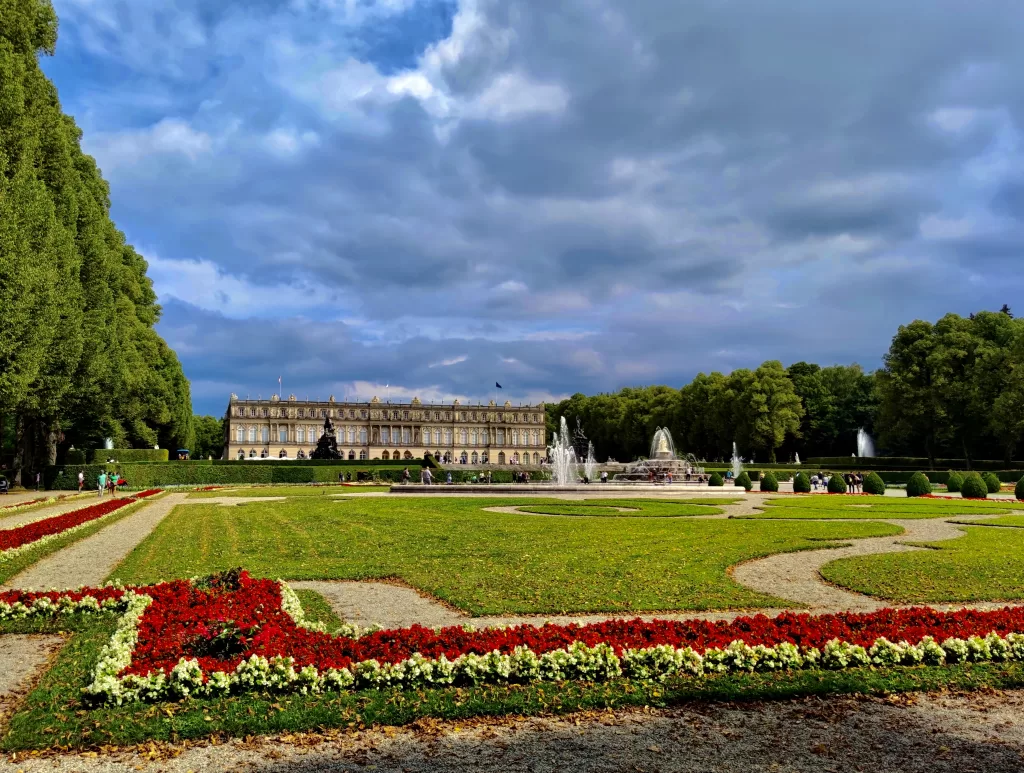 While the grandeur of Versailles’ gardens couldn’t be replicated due to the island’s size and terrain, a French-style garden was still designed to accompany the palace. Although the original plans were never fully realized – due to budget constraints and the untimely death of King Ludwig II – the garden that exists today is still quite charming.
While the grandeur of Versailles’ gardens couldn’t be replicated due to the island’s size and terrain, a French-style garden was still designed to accompany the palace. Although the original plans were never fully realized – due to budget constraints and the untimely death of King Ludwig II – the garden that exists today is still quite charming.
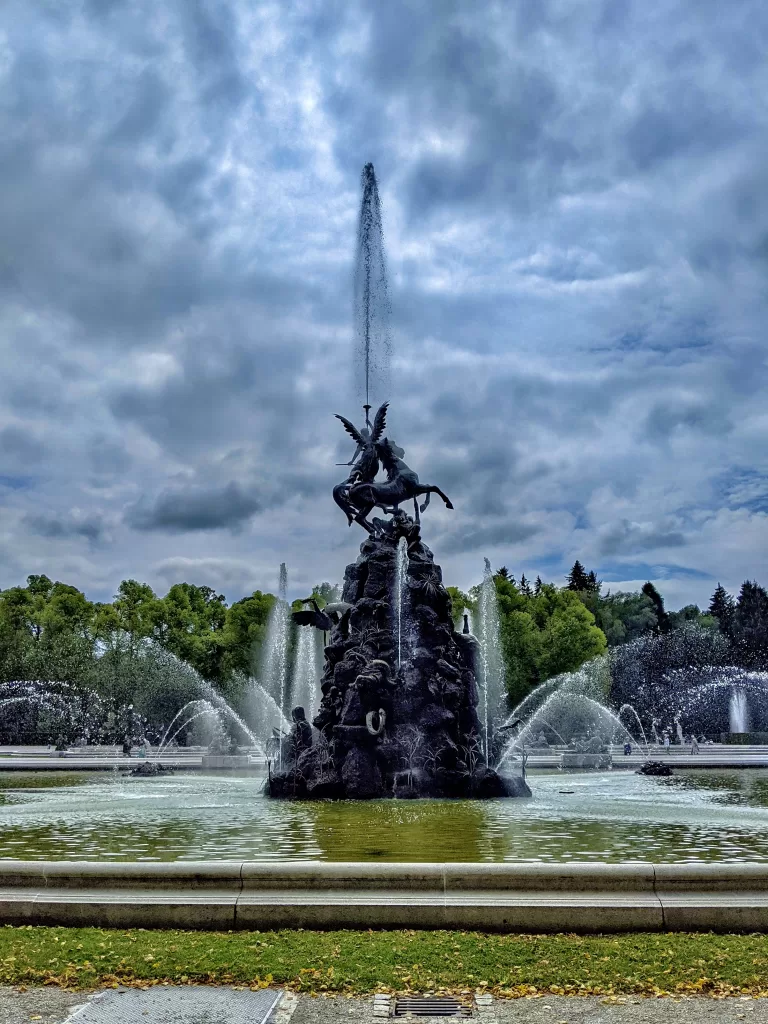
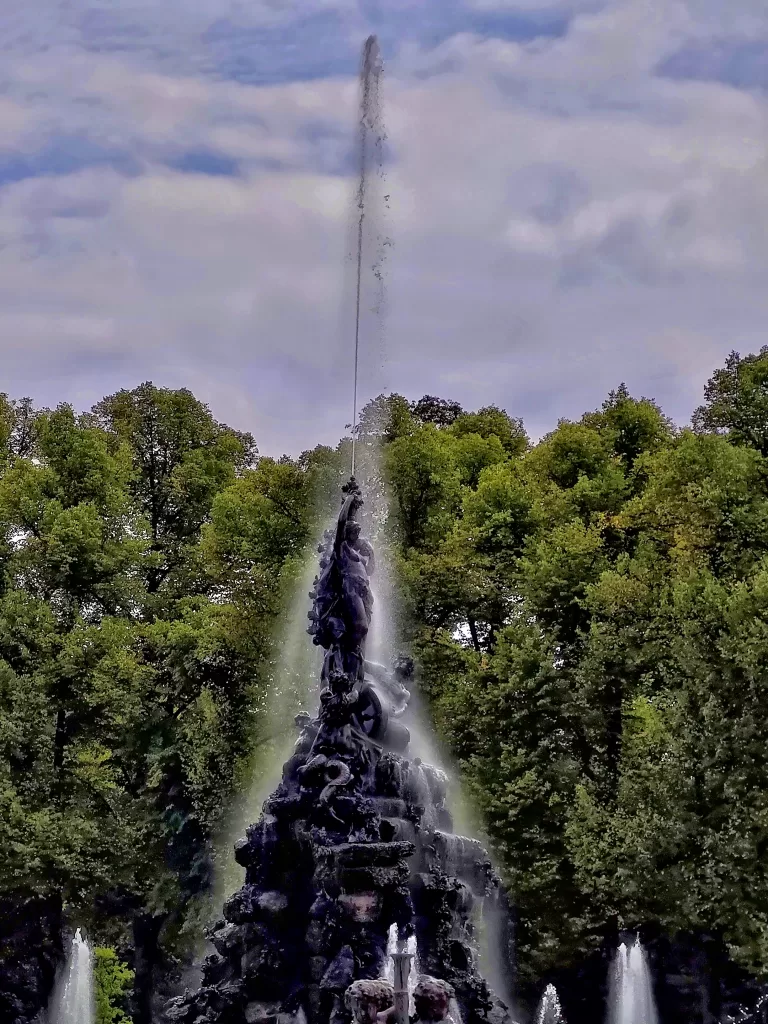 As a tribute to Versailles, two striking fountains adorn the palace’s front facade: Fama-Brunnen and Fortuna-Brunnen. Unlike their Versailles counterparts, these fountains feature statues at their tips that spray water on the hour. Adjacent to these are two smaller marble fountains adorned with lion statues and figures from European folklore.
As a tribute to Versailles, two striking fountains adorn the palace’s front facade: Fama-Brunnen and Fortuna-Brunnen. Unlike their Versailles counterparts, these fountains feature statues at their tips that spray water on the hour. Adjacent to these are two smaller marble fountains adorned with lion statues and figures from European folklore.
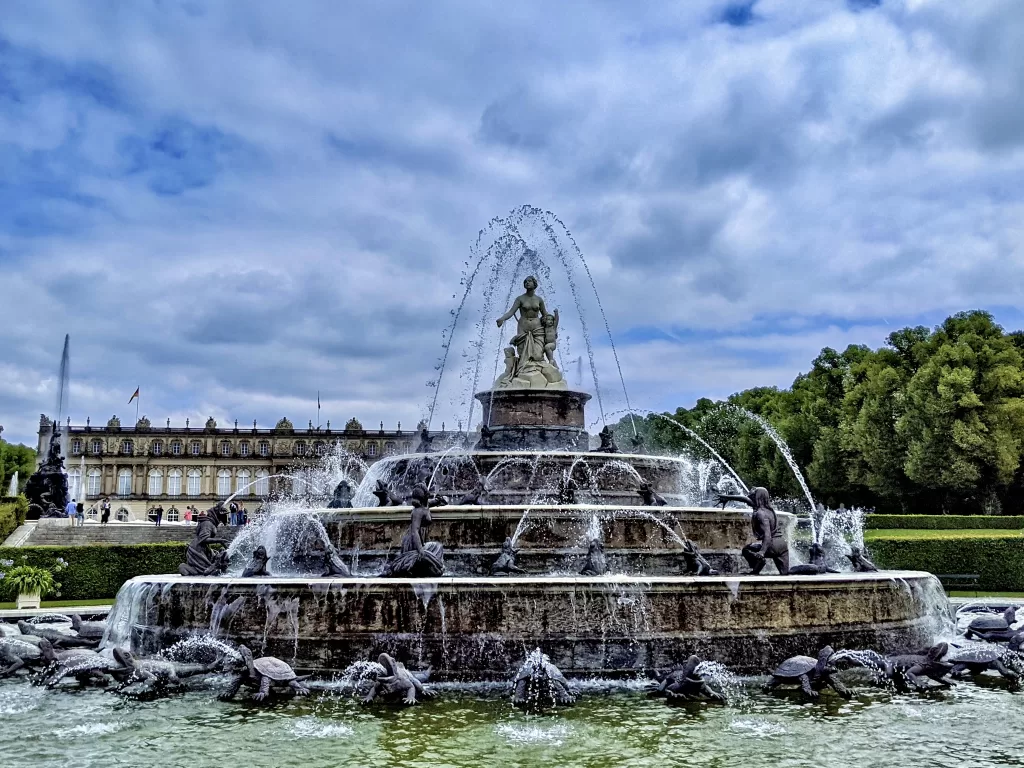 Descending the garden stairs brings us closer to the main fountain, Latona-Brunnen. As I mentioned earlier, the garden is designed in the French style. Personally, I find it a bit too flat and unvaried for my taste. I’m more drawn to the unpredictability and diverse elements found in English and Chinese gardens, which always have a way of surprising me.
Descending the garden stairs brings us closer to the main fountain, Latona-Brunnen. As I mentioned earlier, the garden is designed in the French style. Personally, I find it a bit too flat and unvaried for my taste. I’m more drawn to the unpredictability and diverse elements found in English and Chinese gardens, which always have a way of surprising me.
The Schloss:
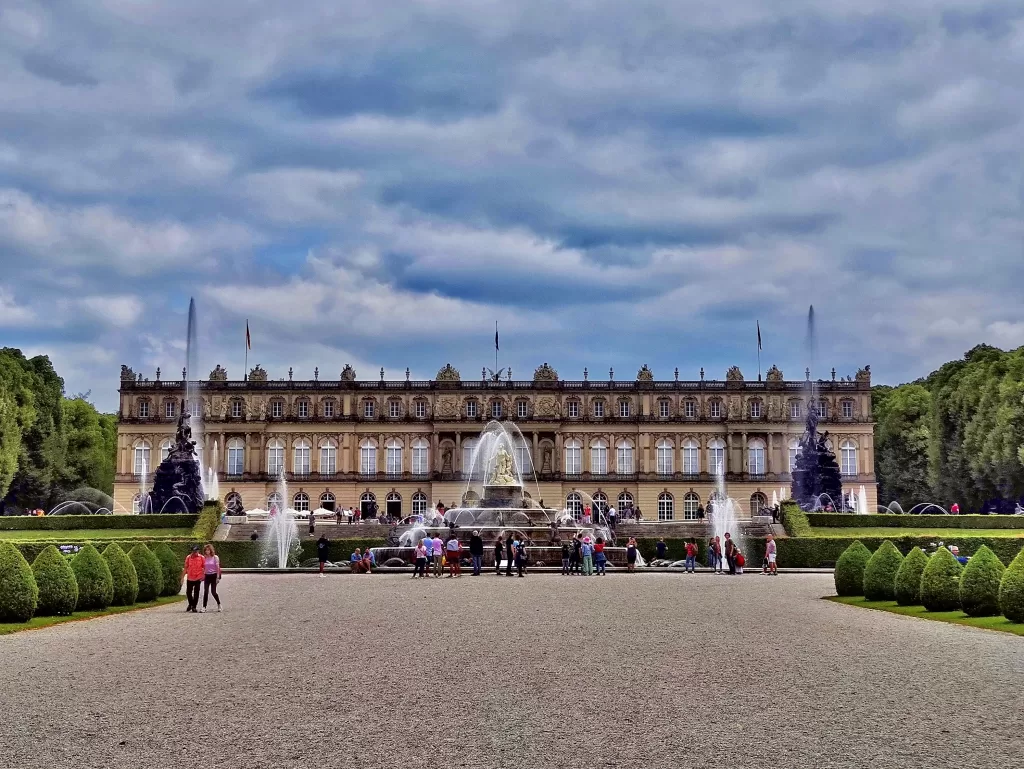 The planning for this palace began shortly after the construction of Neuschwanstein had commenced. However, due to the death of Ludwig II’s uncle and the subsequent Franco-Prussian War, the project was put on hold for an extended period. Once the war concluded, Ludwig II finally had the opportunity to visit Versailles, which inspired him to resume construction. He would regularly stay at the Monastery (the Old Royal Palace of Chiemsee) to oversee the palace’s construction. Although the palace was not completed before Ludwig II’s death, he did spend several months residing there.
The planning for this palace began shortly after the construction of Neuschwanstein had commenced. However, due to the death of Ludwig II’s uncle and the subsequent Franco-Prussian War, the project was put on hold for an extended period. Once the war concluded, Ludwig II finally had the opportunity to visit Versailles, which inspired him to resume construction. He would regularly stay at the Monastery (the Old Royal Palace of Chiemsee) to oversee the palace’s construction. Although the palace was not completed before Ludwig II’s death, he did spend several months residing there.
While the palace drew inspiration from the Palace of Versailles, it also featured several modern improvements. For instance, it was equipped with a more advanced heating system. A crank mechanism inside the palace allowed the dining table to be transported directly between the King’s dining room and the servants’ quarters, similar to Neuschwanstein.
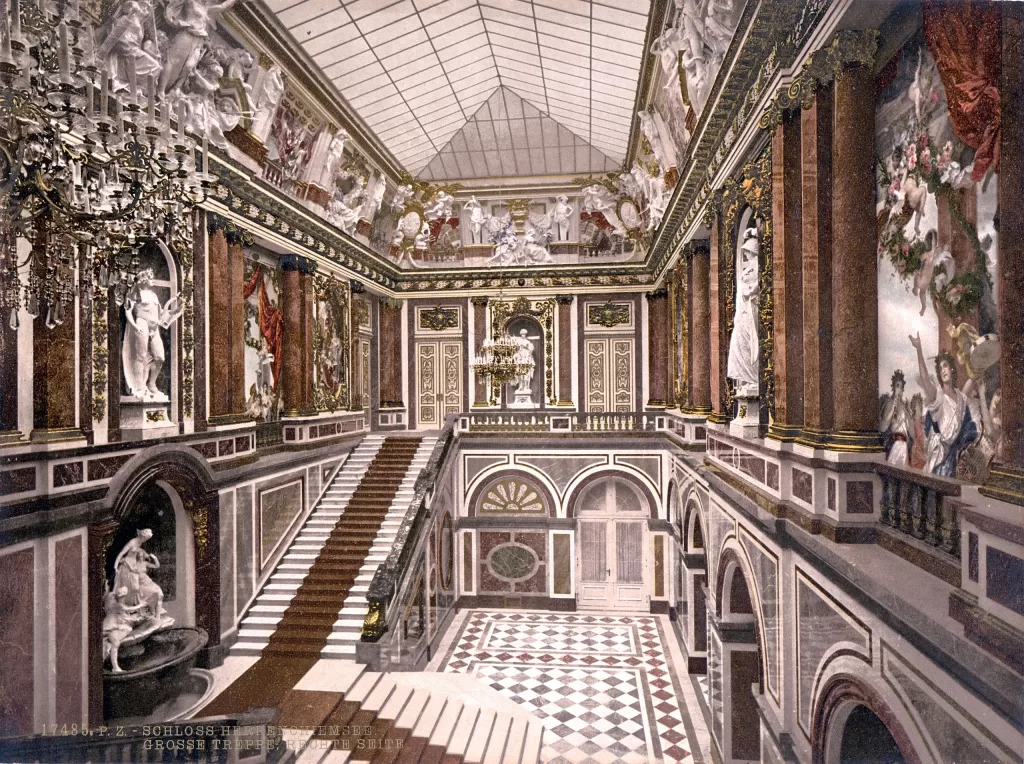 Upon entering the palace, the tour begins with the grand staircase, which closely resembles the Ambassador’s Staircase at Versailles. The staircase is truly marvelous, adorned with intricate marbles and statues. As we move to the anterooms, we notice that all the paintings on the walls depict scenes from Versailles, none feature stories or tales from Germany or Bavaria. Unfortunately, some of these paintings are already peeling, and I hope they can be better preserved.
Upon entering the palace, the tour begins with the grand staircase, which closely resembles the Ambassador’s Staircase at Versailles. The staircase is truly marvelous, adorned with intricate marbles and statues. As we move to the anterooms, we notice that all the paintings on the walls depict scenes from Versailles, none feature stories or tales from Germany or Bavaria. Unfortunately, some of these paintings are already peeling, and I hope they can be better preserved. 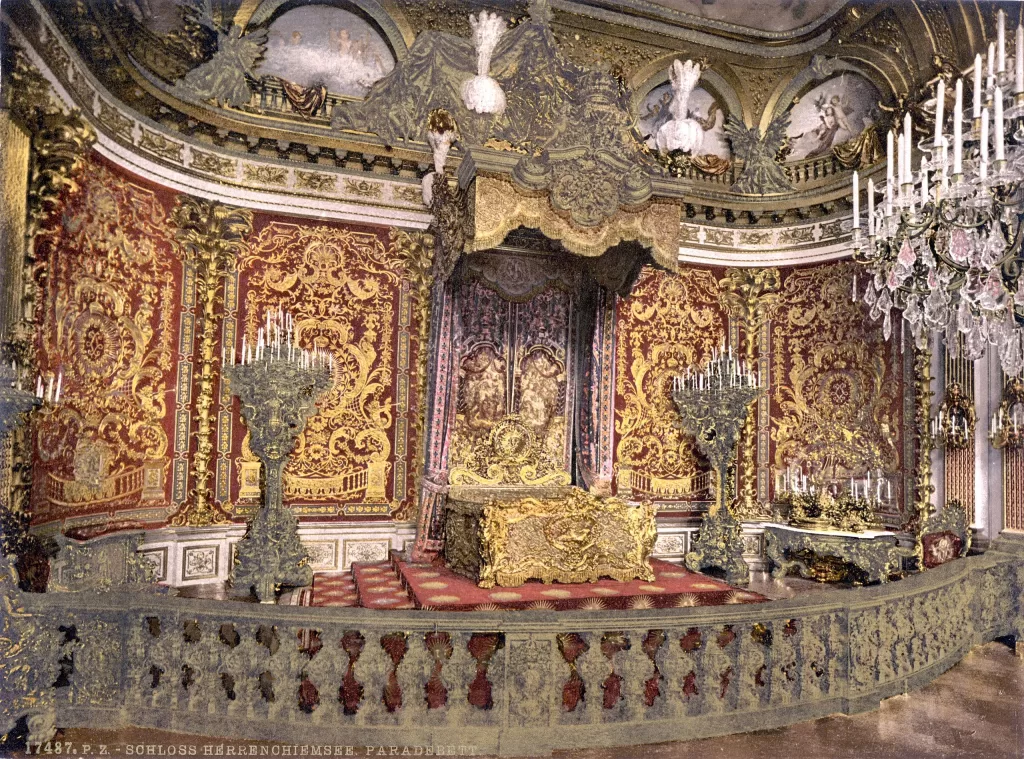 We then proceed to the King’s State Bedroom, an exact replica of Louis XIV’s bedroom in Versailles. It’s grand, detailed, and extravagant. Ludwig II used this room solely as a private space to honor Louis XIV. The Mirror Hall in Herrenchiemsee was intended to mimic the one in Versailles but ended up being even longer. From every mirror in the hall, one can see the garden.
We then proceed to the King’s State Bedroom, an exact replica of Louis XIV’s bedroom in Versailles. It’s grand, detailed, and extravagant. Ludwig II used this room solely as a private space to honor Louis XIV. The Mirror Hall in Herrenchiemsee was intended to mimic the one in Versailles but ended up being even longer. From every mirror in the hall, one can see the garden.
The King’s personal bedroom is lavishly covered in gold, and the blue accents on the bed make it feel more livable. Next, we enter my favorite part of the palace: the Dining Room. Ludwig II lived here alone, except for his servants. He preferred to dine in alone, which is why the table was designed to be raised and lowered for serving food. A particularly striking feature is a porcelain vase, even the “flowers” were made of porcelain. What is more astonishing is that another Meissen porcelain chandelier hangs above the table.
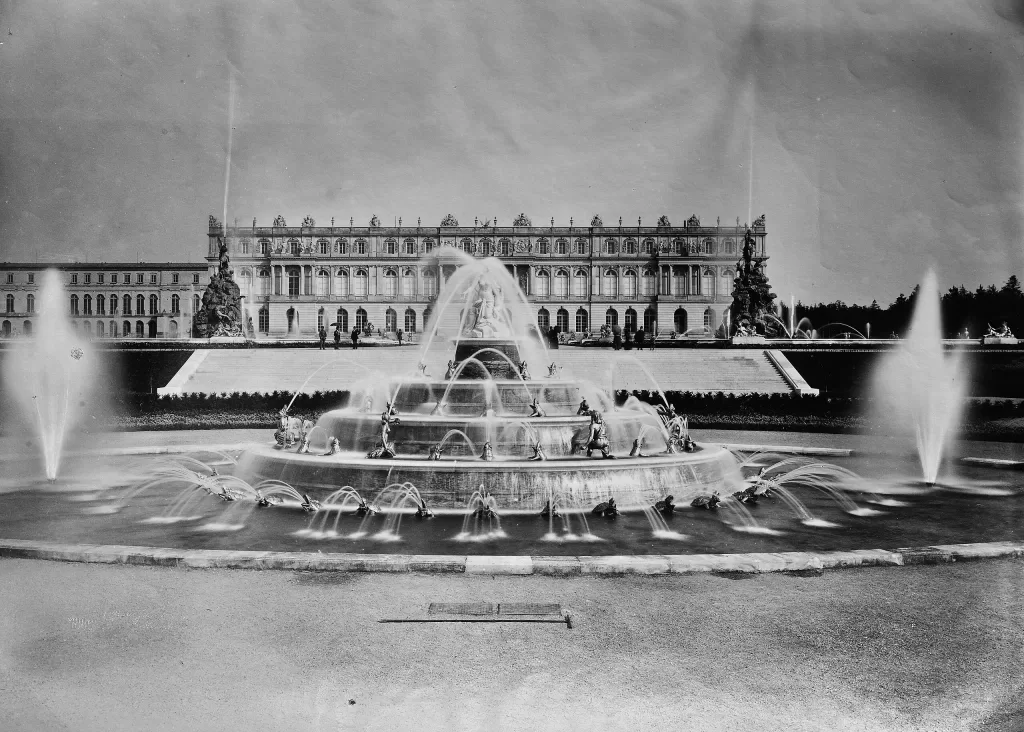 Our tour concludes with a walk through a salon, another study, and a bathroom. The staircase we exit by, the northern stairs, was never completed, leaving only bare bricks visible. It’s unfortunate that other parts of the palace were left unfinished. The structure of the northern wing was dismantled because the southern wing was never built, disrupting the palace’s symmetry.
Our tour concludes with a walk through a salon, another study, and a bathroom. The staircase we exit by, the northern stairs, was never completed, leaving only bare bricks visible. It’s unfortunate that other parts of the palace were left unfinished. The structure of the northern wing was dismantled because the southern wing was never built, disrupting the palace’s symmetry.
This marks the end of our journey. We can now catch the ferry back to the mainland and then board a train to Munich. However, if time permits, I highly recommend staying a bit longer to explore other islands and soak in the breathtaking views of the lake with the Alps serving as a majestic backdrop.
A word of caution: be prepared for potential train delays on the return trip to Munich. Border checks are common, especially for travelers coming from Austria to Germany.
Exploring Neues Schloss Herrenchiemsee: Bavaria's Versailles and the Legacy of King Ludwig II

This is our second journey to King Ludwig II of Bavaria’s castles and palaces. Today, we’re exploring Neues Schloss Herrenchiemsee (Herrenchiemsee New Palace). Often called the “Versailles of Bavaria,” this palace was inspired by Louis XIV’s (The Sun King) grand Versailles. King Ludwig II, an admirer of Louis XIV, even referred to himself as the “Moon King.” This palace was the second one Ludwig II planned, following Schloss Neuschwanstein but preceding Schloss Linderhof.
Best time to visit: Late Spring to early Autumn 🌳🍁
I wouldn’t recommend visiting palaces in winter because the gardens lose their lushness, and statues are covered to protect them from freezing temperatures.
How to get there:
We take a train, either BRB or EC, from München Hbf (Munich Main Station) to Prien am Chiemsee. The journey takes around an hour. Make sure to check Deutsche Bahn’s website for ticket prices.

After arriving in Prien, a quaint town in southern Bavaria, we head to the port to catch a ferry to Herreninsel on Chiemsee (Lake Chiem). The port is accessible via a charming old train platform, Chiemseebahn, Bahnhof Prien, located side by side the modern station. Tickets are cash-only, so make sure to withdraw some before your trip.

Tip: I always opt for round-trip tickets to avoid last-minute ticket-buying stress.
The train to the port, Chiemsee “Prien,” is a vintage model, and you’ll notice that nobody closes the windows. That’s because everyone is busy capturing the scenic views on their cameras and phones. Once we arrive, our next stop is the ticket counter to purchase ferry tickets. You’ll have options: Herreninsel (Men’s Island) and Fraueninsel (Women’s Island) are both accessible from here. For today’s adventure, we’ll opt for a round-trip ticket to Herreninsel. The lakeside is a popular spot for relaxation, so feel free to take a leisurely stroll while waiting for the ferry.

Finally, the ferry arrives, and we’re off to Herreninsel. Even though it’s the height of summer, the lake air retains a slight chill. The ferry’s movement creates an airflow that makes it easier for seagulls to glide alongside us. They’re a common sight, but it’s best to admire them from a distance and respect their space.

About 15 minutes later, we reach Herreninsel. Our first task is to head to the ticket counter once more to book a guided tour of the palace. Both English and German tours are available, but remember, they only accept cash.

With approximately an hour to spare before our tour begins, we have the freedom to explore the island further. You’ll notice that it’s not just a human haven, horses and cows roam freely here as well. However, be cautious – horse-flies are prevalent, and they won’t hesitate to follow and bite you!
Schlosspark Herrenchiemsee: The Palace Garden:

While the grandeur of Versailles’ gardens couldn’t be replicated due to the island’s size and terrain, a French-style garden was still designed to accompany the palace. Although the original plans were never fully realized – due to budget constraints and the untimely death of King Ludwig II – the garden that exists today is still quite charming.

As a tribute to Versailles, two striking fountains adorn the palace’s front facade: Fama-Brunnen and Fortuna-Brunnen. Unlike their Versailles counterparts, these fountains feature statues at their tips that spray water on the hour. Adjacent to these are two smaller marble fountains adorned with lion statues and figures from European folklore.

Descending the garden stairs brings us closer to the main fountain, Latona-Brunnen. As I mentioned earlier, the garden is designed in the French style. Personally, I find it a bit too flat and unvaried for my taste. I’m more drawn to the unpredictability and diverse elements found in English and Chinese gardens, which always have a way of surprising me.

The Schloss:

The planning for this palace began shortly after the construction of Neuschwanstein had commenced. However, due to the death of Ludwig II’s uncle and the subsequent Franco-Prussian War, the project was put on hold for an extended period. Once the war concluded, Ludwig II finally had the opportunity to visit Versailles, which inspired him to resume construction. He would regularly stay at the Monastery (the Old Royal Palace of Chiemsee) to oversee the palace’s construction. Although the palace was not completed before Ludwig II’s death, he did spend several months residing there.
While the palace drew inspiration from the Palace of Versailles, it also featured several modern improvements. For instance, it was equipped with a more advanced heating system. A crank mechanism inside the palace allowed the dining table to be transported directly between the King’s dining room and the servants’ quarters, similar to Neuschwanstein.

Upon entering the palace, the tour begins with the grand staircase, which closely resembles the Ambassador’s Staircase at Versailles. The staircase is truly marvelous, adorned with intricate marbles and statues. As we move to the anterooms, we notice that all the paintings on the walls depict scenes from Versailles, none feature stories or tales from Germany or Bavaria. Unfortunately, some of these paintings are already peeling, and I hope they can be better preserved.

We then proceed to the King’s State Bedroom, an exact replica of Louis XIV’s bedroom in Versailles. It’s grand, detailed, and extravagant. Ludwig II used this room solely as a private space to honor Louis XIV. The Mirror Hall in Herrenchiemsee was intended to mimic the one in Versailles but ended up being even longer. From every mirror in the hall, one can see the garden.
The King’s personal bedroom is lavishly covered in gold, and the blue accents on the bed make it feel more livable. Next, we enter my favorite part of the palace: the Dining Room. Ludwig II lived here alone, except for his servants. He preferred to dine in alone, which is why the table was designed to be raised and lowered for serving food. A particularly striking feature is a porcelain vase, even the “flowers” were made of porcelain. What is more astonishing is that another Meissen porcelain chandelier hangs above the table.

Our tour concludes with a walk through a salon, another study, and a bathroom. The staircase we exit by, the northern stairs, was never completed, leaving only bare bricks visible. It’s unfortunate that other parts of the palace were left unfinished. The structure of the northern wing was dismantled because the southern wing was never built, disrupting the palace’s symmetry.
This marks the end of our journey. We can now catch the ferry back to the mainland and then board a train to Munich. However, if time permits, I highly recommend staying a bit longer to explore other islands and soak in the breathtaking views of the lake with the Alps serving as a majestic backdrop.
A word of caution: be prepared for potential train delays on the return trip to Munich. Border checks are common, especially for travelers coming from Austria to Germany.